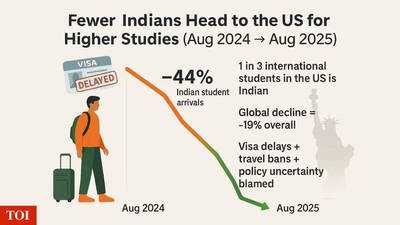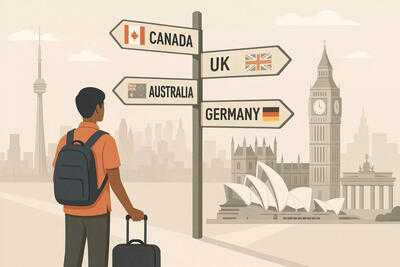The number of Indian students travelling to the United States has fallen sharply this year, marking the steepest decline on record outside the pandemic. According to new Trade.gov data analysed by The New York Times , student arrivals from India dropped by 44 percent in August 2025 compared with the same period last year. For a country that now sends nearly one in three foreign students to American universities, this represents a major shift in global education flows.
The decline in numbers
The US has long been the preferred destination for Indian students seeking higher education, particularly in science, technology, engineering and mathematics (STEM). But this year, the data tells a different story.
Student arrivals from India fell 44 percent, the sharpest fall among all major source countries.
Overall international student arrivals to the US dropped 19 percent, indicating that the fall among Indians is far steeper than the global average.
The downturn follows a smaller decline last year, showing a continuing trend rather than a one-time disruption.
At a time when over 1.3 million international students study in the US, this decline suggests a structural shift — one that may affect both universities and the American economy.

Why are fewer Indians going to the US?
1. Visa delays and administrative backlogs
In late May, the US State Department suspended student visa interviews for three weeks — right in the middle of the peak application season. When interviews resumed, appointment wait times stretched into months. As a result, many Indian students could not get their F-1 visas in time for the autumn semester.
Data from the same period shows a 22 percent drop in F-1 visa issuances compared to last year. This was compounded by delays at Indian consulates already struggling with post-pandemic demand.
2. A tougher immigration climate
The Trump administration’s policies have added further uncertainty. In 2025, the US imposed new travel bans and visa restrictions on 19 countries, and increased scrutiny of all foreign applicants.
Applicants are now required to make their social media profiles public for “comprehensive vetting.” Earlier this year, the government revoked over 1,500 student visas — later reinstating them — and announced plans to “aggressively review” Chinese student visas, which has had a chilling effect across Asia.
Though India was not directly targeted, the atmosphere of suspicion and unpredictability has affected all foreign students.
3. Fear and uncertainty on campuses
A series of government actions against international students has deepened concerns. In March, several were detained and threatened with deportation for participating in pro-Palestinian protests, before a court later ruled the move unconstitutional.
Universities have since advised many students to avoid leaving the country, warning they might face re-entry problems. For those still abroad, the uncertainty has made the US appear less welcoming and less stable.
4. Rising costs and post-study restrictions
The recently introduced $100,000 H-1B work visa fee — which affects foreign graduates seeking employment in the US — has further discouraged applications. Combined with high living costs and fears over job prospects, many Indian students are reconsidering their options.
Where are Indian students going instead?

The decline in US-bound students does not necessarily mean fewer Indians are studying abroad — rather, they are diversifying their destinations.
The impact on US universities
The consequences are already visible. American universities — particularly STEM-heavy graduate programmes and state colleges — depend heavily on Indian students, who pay full tuition and often fill key teaching or research assistant roles.
These numbers translate into not just financial strain but also staffing challenges in laboratories and classrooms.
The Association of International Educators (NAFSA) estimates that the overall decline in international students could cost the US economy around $7 billion this academic year.
What this means for the future
For decades, Indian students have been a cornerstone of America’s academic and technological ecosystem. Nearly three-quarters of international PhD graduates in science and engineering stay and work in the US after completing their studies. A prolonged decline could therefore affect the country’s research output and talent pool.
For India, the shift underscores a changing global education landscape — one where Western dominance is no longer guaranteed, and students are making pragmatic choices about safety, cost and career pathways.
The 44 percent drop in 2025 may be an early warning that the “American Dream” for education is fading for many young Indians — not because of a lack of ambition, but because of rising barriers and shrinking certainty.
The decline in numbers
The US has long been the preferred destination for Indian students seeking higher education, particularly in science, technology, engineering and mathematics (STEM). But this year, the data tells a different story.
Student arrivals from India fell 44 percent, the sharpest fall among all major source countries.
Overall international student arrivals to the US dropped 19 percent, indicating that the fall among Indians is far steeper than the global average.
The downturn follows a smaller decline last year, showing a continuing trend rather than a one-time disruption.
At a time when over 1.3 million international students study in the US, this decline suggests a structural shift — one that may affect both universities and the American economy.
Why are fewer Indians going to the US?
1. Visa delays and administrative backlogs
In late May, the US State Department suspended student visa interviews for three weeks — right in the middle of the peak application season. When interviews resumed, appointment wait times stretched into months. As a result, many Indian students could not get their F-1 visas in time for the autumn semester.
Data from the same period shows a 22 percent drop in F-1 visa issuances compared to last year. This was compounded by delays at Indian consulates already struggling with post-pandemic demand.
2. A tougher immigration climate
The Trump administration’s policies have added further uncertainty. In 2025, the US imposed new travel bans and visa restrictions on 19 countries, and increased scrutiny of all foreign applicants.
Applicants are now required to make their social media profiles public for “comprehensive vetting.” Earlier this year, the government revoked over 1,500 student visas — later reinstating them — and announced plans to “aggressively review” Chinese student visas, which has had a chilling effect across Asia.
Though India was not directly targeted, the atmosphere of suspicion and unpredictability has affected all foreign students.
3. Fear and uncertainty on campuses
A series of government actions against international students has deepened concerns. In March, several were detained and threatened with deportation for participating in pro-Palestinian protests, before a court later ruled the move unconstitutional.
Universities have since advised many students to avoid leaving the country, warning they might face re-entry problems. For those still abroad, the uncertainty has made the US appear less welcoming and less stable.
4. Rising costs and post-study restrictions
The recently introduced $100,000 H-1B work visa fee — which affects foreign graduates seeking employment in the US — has further discouraged applications. Combined with high living costs and fears over job prospects, many Indian students are reconsidering their options.
Where are Indian students going instead?
The decline in US-bound students does not necessarily mean fewer Indians are studying abroad — rather, they are diversifying their destinations.
- Canada has seen a sharp rise in Indian enrolments, thanks to simpler visa procedures and work-permit pathways after graduation.
- The United Kingdom has also attracted record numbers of Indian students, aided by its post-study work visa and universities actively courting Indian applicants.
- Australia and Germany are emerging as other popular alternatives, especially for engineering and computer science programmes.
The impact on US universities
The consequences are already visible. American universities — particularly STEM-heavy graduate programmes and state colleges — depend heavily on Indian students, who pay full tuition and often fill key teaching or research assistant roles.
- At the University of Central Missouri, new international student enrolments have fallen by half.
- DePaul University in Chicago reported a 62 percent drop in new international graduate enrolments this year.
- State schools such as Ohio State University and Indiana University have seen 30–40 percent declines in new foreign admissions.
These numbers translate into not just financial strain but also staffing challenges in laboratories and classrooms.
The Association of International Educators (NAFSA) estimates that the overall decline in international students could cost the US economy around $7 billion this academic year.
What this means for the future
For decades, Indian students have been a cornerstone of America’s academic and technological ecosystem. Nearly three-quarters of international PhD graduates in science and engineering stay and work in the US after completing their studies. A prolonged decline could therefore affect the country’s research output and talent pool.
For India, the shift underscores a changing global education landscape — one where Western dominance is no longer guaranteed, and students are making pragmatic choices about safety, cost and career pathways.
The 44 percent drop in 2025 may be an early warning that the “American Dream” for education is fading for many young Indians — not because of a lack of ambition, but because of rising barriers and shrinking certainty.
You may also like

UKHSA urging people to 'get tested' for virus that 'can affect anyone'

Mrunal Thakur flaunts her playfulness in her “vanity to insanity” video diaries

Ayushmann Khurrana opens up about his struggles as a young journalist: 'It's never easy saying no'

Paul Scholes names surprise pick as Premier League's best midfielder - 'Better than Rice'

Time ripe to have 1st Indian defence unicorn soon: Rajnath Singh






